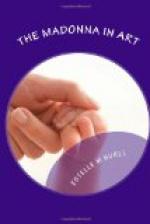[Illustration: UMBRIAN SCHOOL.—GLORIFICATION OF THE VIRGIN.]
The first has come down to us from the hand of some unknown Umbrian painter. In the National Gallery, London, where it now hangs, it was once attributed to Lo Spagna, but is now entered in the catalogue as nameless. It matters little whether or not we know the name of the master; he could ask no higher tribute to his talent than the universal admiration which his picture commands.
In the foreground of a quiet Umbrian landscape is a marble balcony, on the railing of which sit two captivating little boy choristers. One roguish fellow pipes on a trumpet, while the other, his face tip-tilted to the heavenly vision, makes music on a small guitar. Above, on a cloud, sits the Virgin, with the sweet, mystic smile on her face, so characteristic of Umbrian art. She supports her babe with her right arm, and in her left hand carries a lily stalk. The child, standing on his mother’s knee and clinging to her neck, turns his face out with sweet earnestness. In clouds at the side, tiny cherubs bear tapers, while others, floating above, hold a large crown just over her head.
Although we cannot limit this style of picture to any special locality, it appears to have found much favor in the art of Northern Italy. In the Brescian school, Moretto was unusually fond of the subject. His treatment of the theme is somewhat heavy; there is little of the ethereal in his celestial vision, either in the type of womanhood or in the style of arrangement. In defiance of the law of gravitation, he poses his upper figures so as to form a solid pyramid, wide at the base, and tapering abruptly to the apex.
[Illustration: MORETTO.—MADONNA IN GLORY.]
In the glorified Madonna of St. John the Evangelist, Brescia, the pyramidal effect is accentuated by curtains draped back on either side of the upper part of the composition. In the Madonna of San Giorgio Maggiore, at Verona, we have a much more attractive picture. The “gloria” encompassing the vision is clearly defined, giving so strong an effect of the supernatural that we cease to judge the composition by ordinary standards of natural law. The Virgin’s white veil flutters from her head as if caught by some heavenly breeze. Her cloak floats about her by the same mysterious force, held in graceful festoons by winged cherub heads.
Below is a group of five virgin martyrs, with St. Cecilia in the centre, wearing a crown of roses; St. Lucia holds the awl, the instrument of her torture, looking down at St. Catherine, who leans against her terrible wheel; St. Agnes, on the other side, reads quietly from a book while she caresses her lamb, and St. Barbara stands behind her, with eyes lifted to the sky. They are all splendid young Amazons, recalling Moretto’s fine St. Justina of the Vienna Gallery. There is no trace of ascetism in their strong, well-developed figures, and in their faces no suggestion of an unhealthy pietism.




